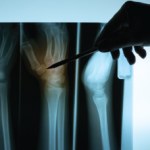NEW YORK (Reuters Health)—Pulse-echo ultrasound is a useful method for point-of-care osteoporosis screening, researchers from Finland report.
“To effectively increase diagnostic coverage, this kind of device should be in every primary or occupational healthcare unit,” Dr. Janne P. Karjalainen from the University of Eastern Finland in Kuopio tells Reuters Health by email.
Currently, osteoporosis is defined by the World Health Organization as bone mineral density (BMD) 2.5 standard deviations or below the mean for young adults, with dual-energy X-ray absorptiometry (DXA) considered as the gold standard for its diagnosis.
Dr. Karjalainen and colleagues investigated the association between proximal femur BMD and novel pulse-echo ultrasound measurements and suggested diagnostic thresholds for ultrasound density index (DI) in their study of 572 women (ages 20–91 years).
The ultrasound device provides two indices based on 1) a single-site measurement of cortical thickness at the proximal tibia (DI1); and 2) a three-site measurement of cortical thickness at the distal radius, proximal tibia, and distal tibia (DI3).
DI3 showed a somewhat stronger correlation (r=0.69) with total BMD than did DI1 (r=0.62), the team reports in Osteoporosis International, online on Nov. 10.
Both DI1 and DI3 showed significant differences between osteoporotic and healthy women.
Just over a quarter of women (28.7%) with DI3 between 0.876 (90% sensitivity) and 0.803 (90% specificity) thresholds would require an additional examination by axial DXA to verify their diagnosis. Of these women, 82.5% had an osteopenic/osteoporotic T-score at either the femoral neck or total hip.
About a third of women (32.6%) of women with DI1 between the upper and lower thresholds (0.844 and 0.779, respectively) would require an additional DXA.
DXA examinations needed with FRAX(BMI) would include 57.0% of this cohort of women, whereas the ultrasound approach would reduce the percentage of women requiring DXA to 16%.
“The present thresholds for the application of DI to current osteoporosis management pathways show promise for the technique to decrease the amount of DXA referrals and increase diagnostic coverage,” the researchers conclude. “However, these results need to be confirmed in future studies.”
“Optimally in the future, decisions to treat or not could be based on ultrasound measurement for most of the patients, and only small number would require DXA measurement,” Dr. Karjalainen says.
“Ultrasound could be also applied in conjunction with fracture risk assessment tools (such as FRAX) which would allow not only to assess intrinsic (bone density)-related fracture risk but also extrinsic factors such as history of fracture and parent hip fractures.
